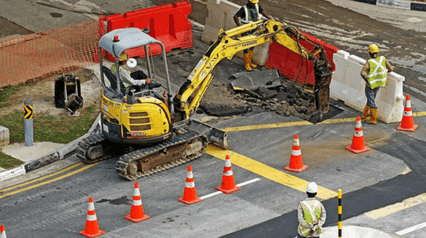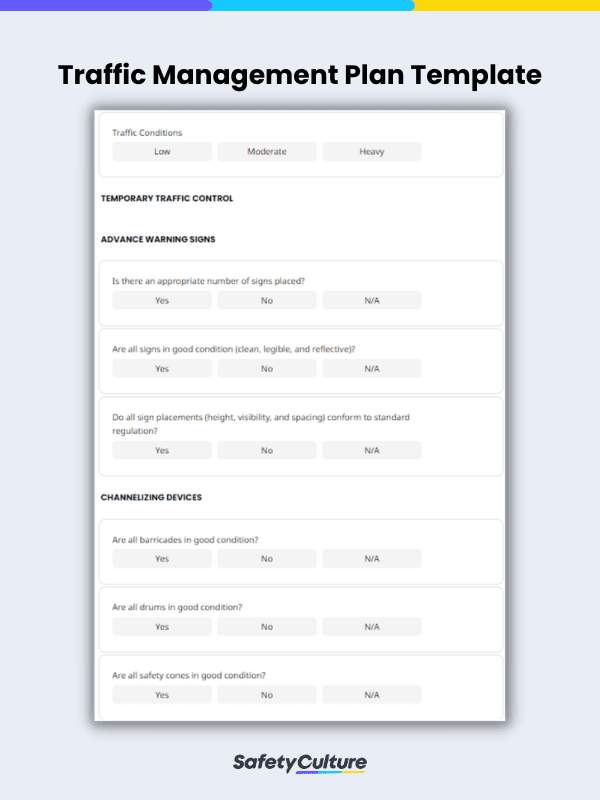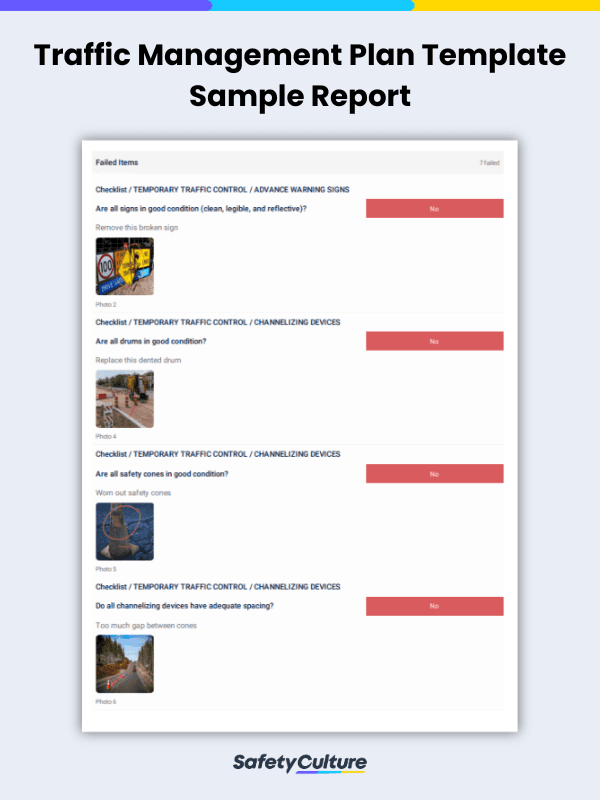What is a Traffic Management Plan Template?
A traffic management plan template is used when planning safe traffic and work zones during roadside construction activities. It is used to keep workers safe from vehicles and equipment both outside and within roadside worksites. Traffic management plan templates can be used to assess workers’ compliance with safety precautions to improve traffic controls, the security of the work area, and general protection of all workers.
What Should a Traffic Management Plan Template Include?
To ensure safety, efficiency, and proper implementation in each traffic control, a basic traffic management plan template should include a comprehensive review of the following items:
- General information (e.g., project description, speed limit, traffic conditions)
- Project representatives
- Advance warning signs
- Channelizing devices
- Pavement markings
- Flagging
- Roadside safety
- Internal traffic control
- Other project-specific items
What Is the Purpose of Traffic Management Plan?
Creating a traffic management plan helps outline the way activities on the road will be implemented so they ensure that both workers and road takers are safe from potential risks and danger. In line with this, a TMP should be approved by a local transport officer prior to any road works and activities.
A traffic management plan also supports workers by determining what safety equipment is needed to protect the affected people such as safety cones, fences, barricades, traffic lights, closed road signs, and other equipment to ensure that work zones are properly and distinctively established. By doing so, traffic management teams will be able to create a protective zone to organize traffic alongside the work being done simultaneously. Lastly, a traffic management plan is vital to ensure that road construction plans and projects are being done safely without disrupting the normal traffic flow.
Elements of a Traffic Management Plan
A traffic management plan does not only cover how workers can be safe when a road project is being completed, but it also contains information on the workaround prepared for cyclists, pedestrians, and other road users. It must contain the specifics of the project as it is completed, such as the location, time shifts, workers involved, the work processes, contact details, as well as traffic management design plans. For a more detailed explanation of what a traffic management plan should cover, here are some of the major points:
#1 Design plan
This should illustrate how the traffic would look like during the operation. Having this would help ensure the safety movements of the vehicles alongside the road work equipment that separates the work area and the established protective zone for road users.
Potential hazards in the area should be identified, and suitable traffic flow should be suggested. Also, it is important to determine the types of vehicles that usually pass through so that proper measurements and distances, such as the width and turning radius, can be considered between the work zone and the main road. Lastly, parking, nearby establishments, and other significant places where people stay or pass-through should also be considered when creating the design plan.
#2 Implementation
Aside from the guidance scheme from the design plans, it should also state the details of when the workers begin doing road construction until they also leave. During the implementation, persons-in charge of performing high-risk tasks should possess and secure the right licenses, registrations, and permits before operating. Compliance documents such as site, legislative, organization, health and safety, and emergency documentation should also be prepared to ensure that the work zone meets all of these requirements. In addition, incidents should also be reported and kept for safety purposes.
#3 Maintenance
Maintenance of the traffic management plans can evolve in 3 design phases. Each phase gives developmental opportunities for traffic planning designers to coordinate the plans to key people. The first design involves rough outlines including the plan notes detailing the sequence of construction and traffic management control. The second phase should cover the major components of the traffic management plan such as advance signing layouts, detour area, and geometry, temporary markings in transitions, intersections, gore areas, barrier wall needs, and special equipment. Lastly, the third phase is the completing stage of the maintenance which involves pay items.
#4 Alteration or Removal of temporary traffic management (TTM)
This should cover how temporal traffic arrangements are altered or removed at the conclusion of the job. This includes the removal of all regulatory signs and equipment, speed restriction signs, barrier systems, temporary markings, and delineation devices. All TTM must be removed in reverse order. Removal might be an easier task compared to planning, installation, and maintenance. However, it should also be planned and performed in a safe manner.
How to Use This Template
This traffic management plan template goes through a detailed process and is easy to use. Follow this step-by-step guide on how to use this checklist:
- Gather basic information – Collect all the basic information about the site such as the name of the person conducting the inspection, type of roadway, traffic conditions, and weather or light conditions. Users are also able to add a photo of the site for reference.
- Prepare a temporary traffic control area – While setting up a temporary traffic control area, traffic planners can go through the checklist whether there are appropriate signs placed. Ensure that all signs, barriers, safety cones, and other tools are in good condition.
- Make sure that the work area is secure and complete – Prepare the work area for uninterrupted work hours. Ensure that there is sufficient space for storing materials and servicing equipment. Personnel must also be trained on street works and provided with a designated channel of communication.
- Summarize and complete the inspection – Summarize your findings, provide recommendations, and indicate whether the traffic management plan qualifies to proceed with the project. Once done, sign off the document.
When completed using a dedicated digital platform, traffic planners may export the file into Web or PDF form that can be easily shared across the organization.
Here is what a sample report of the traffic management plan looks like:
FAQs about Traffic Management Plan Templates
Whether you need to submit a traffic management plan for approval depends on local regulations. In many areas, especially for construction or events affecting traffic, TMP approval from relevant authorities is required. To determine this, check with the local transportation or traffic management agency, such as the Department of Transportation or city/county offices.
Having an approved TMP is crucial for safety and traffic efficiency. Always consult with local authorities to comply with regulations and ensure a smooth process for your project.
TMPs should be reviewed and updated regularly, with an annual review as a general recommendation. Immediate updates are necessary in case of changes to the project, site conditions, or traffic patterns. They should also be revisited if there are any modifications to the construction plan or safety measures.
This ensures ongoing compliance with current standards and the prompt resolution of incidents or near-misses.
Yes, there can be penalties for not having a traffic management Plan (TMP) in place for a construction project. Penalties vary based on local regulations and may include fines, project delays, or work suspension.
Non-compliance not only poses safety risks but also carries potential legal liabilities in case of accidents or disruptions to traffic.



